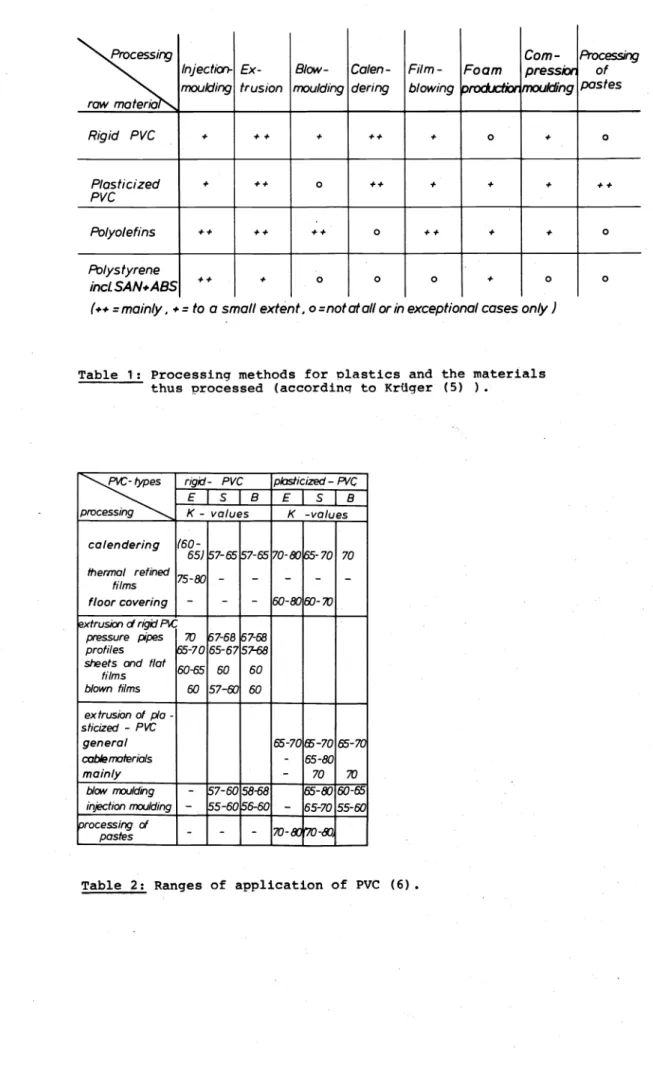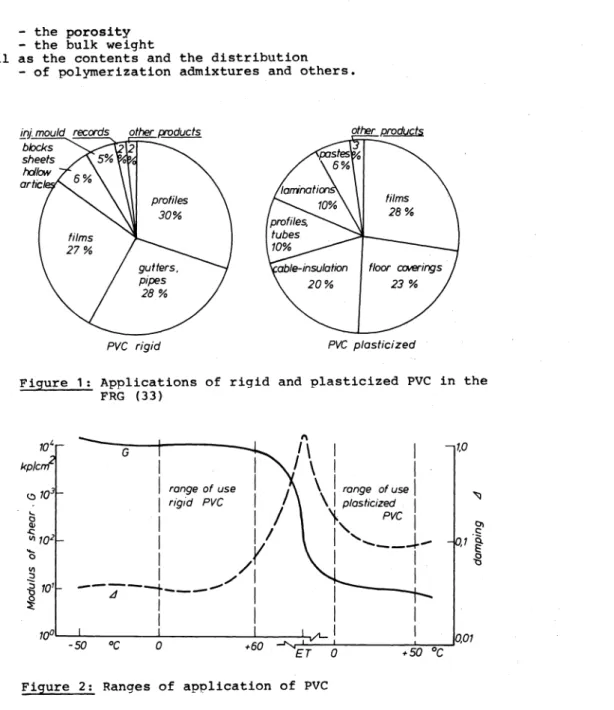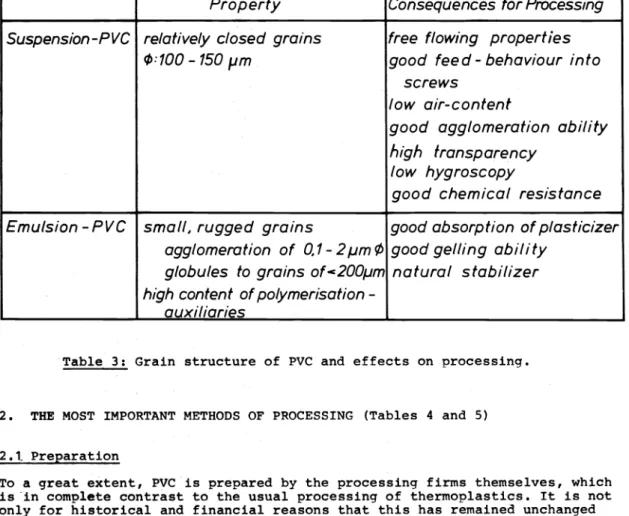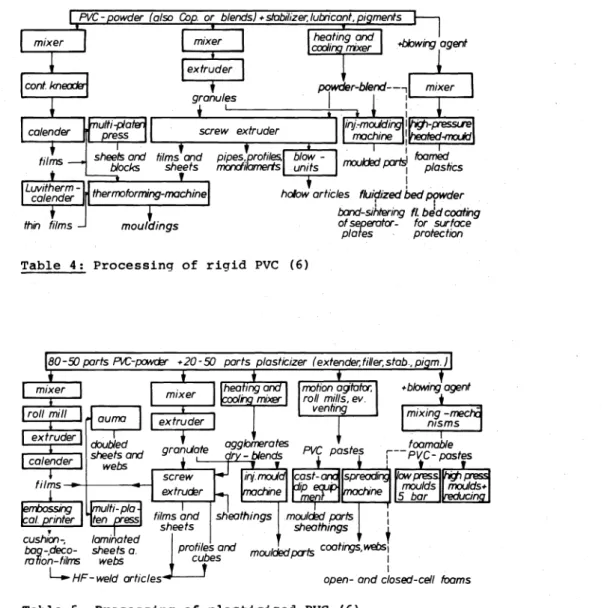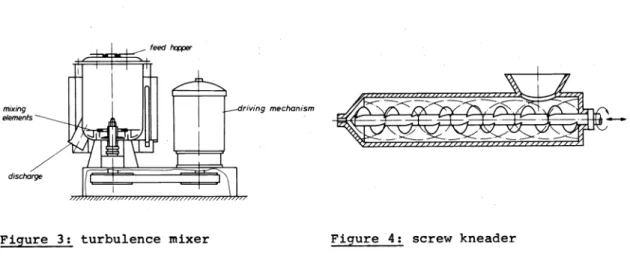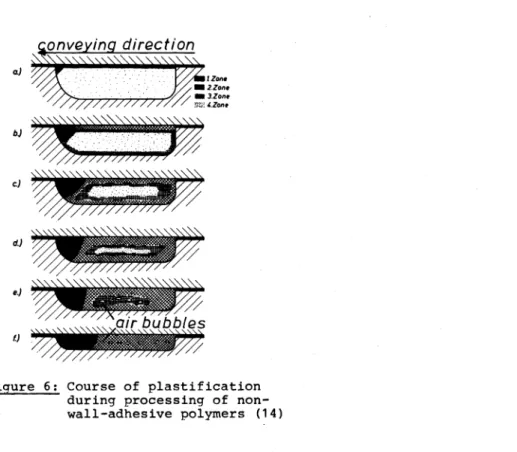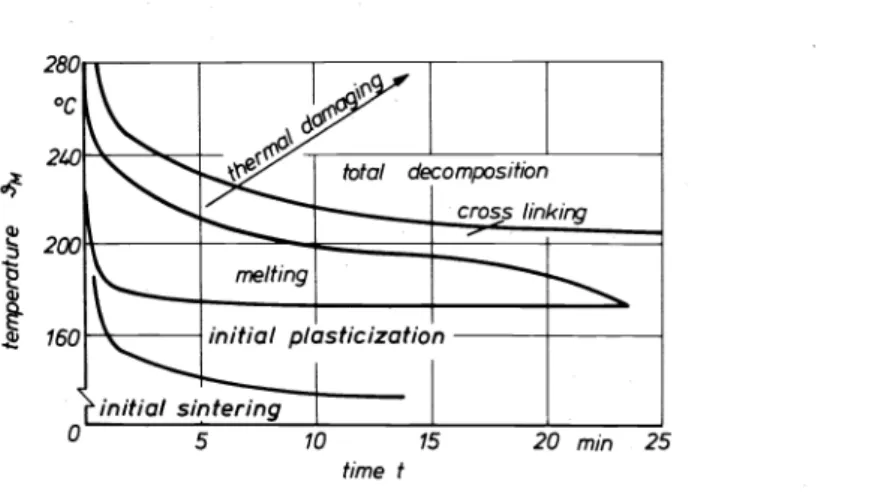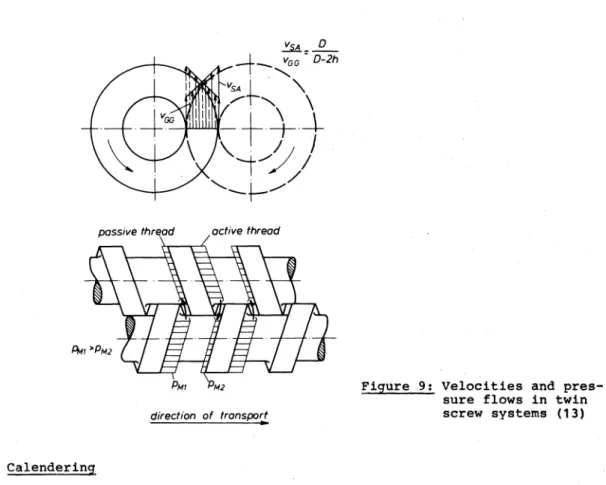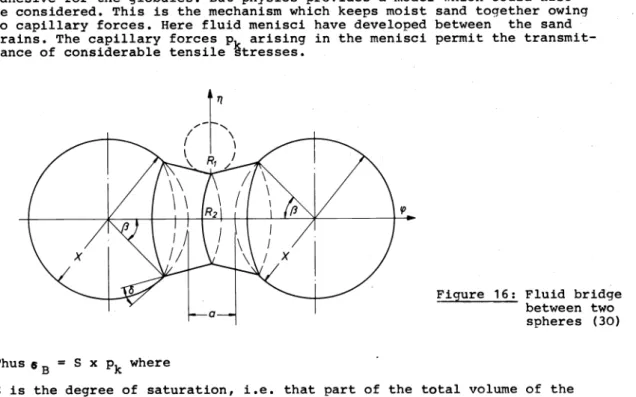POLYVINYL CHLORIDE - PROCESSING AND STRUCTURE
G. Menges and N. Berndtsen
Institut ffir Kunststoffverarbeitung, 51 Aachen
Abstract - Widely different procedures for the processing of PVC have proved themselves and have succeeded in practice on the basis of the special physical and chemical properties of PVC. In this connection a distinction must be made between the processing of plasticized PVC and the relatively difficult processing of rigid PVC. A survey of the most important methods of preparation and processing is given here.
The special, rather abnormal properties of PVC in comparison with other thermoplastics are partly. a result of its characteristic structure. The consequences for preparation and processing must therefore be considered anew. Of course, the globular structure of PVC has an effect on the behaviour of the solid-state material and the melt, too, so that great importance must be attributed to the processes at the parttele interface.
1. INTRODUCTION
Though polyvinyl chloride has been in existence for a long time far less is known about it than about the comparatively new polyolefins. It is incom- parably more difficult to process because of its low decomposition tempe- rature, a fact which impedes laboratory tests, too. M8ny research workers say that chlorine begins splitting off just above 100 C (1,2,3). It shows the lowest activation eriergy for decomposition of all plastics, except
for PVA (4). .
It can be attributed to its low raw-material price - it is a typical recyclinq product of the chemical joint utilities - as well as. to its excellent compatibility with bad low-molecular solvente, the so-called plasticizers, that PVC has nevertheless developed to become the greatest mass plastic at certain times. With the-se plasticizers it builds subsidiary valence qels which have an elastomeric character in the vicinity of room temperature. These so-called plasticized PVCs can easily be processed.
From table 1 where the most important thermoplastics have been listed accordinq to their processinq possibilities it can be seen that plasticized PVC has the largest processing range (5). Moreover, it can be filled with mineral powders up to SO vol.-%. In this form it has already been used a great deal. In doing'so, we have learned more and more to process it also as rigid PVC. - ...
Howeve~ there are special processing procedures for plasticized PVC which cannot be. transferred to other po.lymers, e.g. the processing of pastes
(see table 2). Today, the processing of plas.ticized PVC still accounts for 40 % of a processed tota~ quantity of 1 million tons PVC in the FRG in 1974 (production capacity came to 1,3 million tons per year in the same period). The ranges of application are Ulustrated in figure 1. In recent years, very high increase rates could be registered in the case of riqid PVC for calenderinq foils as well as extruded pipes and profiles. .
The ranges of application are very much connected with its elastic behaviour.
Thus figure 2 gives an excellent survey of the ranges of application and of the influ~:mce of added plasticizers - the log. curveL of the moduluis of shear over the temperature. .
The kind of raw-material~ction~has a considerable influence on the workability. As ea,n be seen from table 2 eertairi kirids of raw material production and cert:~in .molecular weiqhts. (K_-v:alues) are aissoctated with the different processinq procedures (6).Th;_1~ is particulary connected~
with the grain struct:ure, i.e. with 597
:s:
lnjecfial- Ex- BIC1N- Calen- Film- Foam Com-pression moulding trusion moulding dering blowing ~. ,",.,;.·--"9
.
Rigid PVC + ++ + ++ + 0 +
P/osficized + ++ 0 ++ + + +
PVC
Po/yo/efins ++ ++ ++ 0 ++ + +
Polystyrene
++ + 0 0 0 + 0
incLSAN+ABS
(++ =main/y. += fo a sma/1 extimt, o=nofafa/1 orin excepfional cases on/y J
Table 1: Processing methods for olastics and the materials thus processed (accordinq to Krüger (5) ) •
~
rigid- PVC plasticized- PVCE
s
8 Es
Bpro K- values K. -values
calendering (60-
57-65 ~-65 Bs-70
65) 70-80 70
thermal refined
75-80
- - -
films
- -
floor covering -
- -
60-80 ED-10~trusial d rigid P.C
~7-68 ~7-68 pressure pipes 10
profi/es 65-70 65-67
fsr-6'8
s/"eets ond flat
60-65 60 60 films
blown films 60 57-f{) 60 ex trusion of pla -
sticized - PVC
generat 65-70 f5-70 65-70
cablef'f'K1ierials
-
65c80mainly
-
70 70blr:m moulding
-
57-60 58--68 65-80 ED-65 injecfion moulding-
55-60 ~6-60-
65-70 55-6G processing of- - -
70-~ 1')0-&]pasfes
Table 2: Ranges of application of PVC (6).
Processirg of pastes
0
++
0
0
- the porosity - the bulk weight
as well as the contents and the distribution - of polymerization admixtures and others.
PVC rigid PVC p/asficized
Figure 1: Applications of rigid and plasticized PVC in the FRG (33)
range of use rigid PVC
1\
I \
I \
1 1I \ I
range of useI I \
I plasficized 1I '}
PVCIV
II I ,, ___ J.-
1 /
I
I____ _J _../ I I
4 , - - -
I
i I
Figure 2: Ranges of application of PVC
-~
,1 ~
.g
Suspension PVC is clearly dominant in the case· of extrusion but also with calendering. The cornpact grain structure (table 3) and the lack of polymeri- zation auxiliaries are responsible for this. Besides E-PVC often B-PVC is used instead of S-PVC but without being able to attain the quantities of S- and E-PVC.
The ernulsion PVC owes its present irnportance to its grain structure, too, for the grain structure absorbs the plasticizer very well because of its fissuring. Twenty years ago, the ernulsifier residues served as a natural
"stabilizer", particulary in the case of extrusion as rigid PVC. Today the emulsifier content is rather a disadvantage because of its hygroscopy. New procedures have very low emulsifier contents (7).
Properfy Consequences for Processing Suspension-PVC relafively closed grains free flowing properfies
f/>:
100 - 150 J.lffl good feed- behaviour info
screws
low air-confenf
good agglomerafion abilify high fransparency
low hygroscopy
good chemical resisfance Emulsion -PVC sma/1, rugged grains good absorpfion of plasficizer
agglomerafion of 0.1- 2 J.lm f/J good gelfing abilify globules fo grains of-=200J.1m natural sfabilizer high confenf of polymerisafion -
auxiliaries
Table 3: Grain structure of PVC and effects on processing.
2, THE MOST IMPORTANT METHODS OF PROCESSING (Tables 4 and 5) 2,1_ Preparation
To a great extent, PVC is prepared by the processing firms themselves, which is -in complete contrast to the usual processing of thermoplastics. It is not only for historical and financial reasons that this has remained unchanged up to now in spite of all prognoses. But in this way the processing firm can derive the greatest profit from the point of view of specific workability and low costs. This is especially important in the case of this material which is very difficult to process. If you consider that a share of 2 % of stabilizer in a PVC-mixture can cost just as much as the PVC share, this becomes even more understandable. Therefore every processing firm has its own recipes which are kept strictly confidential in most cases. Nevertheless the recipes can also be classified to some extent according to the application
and processing method, ·
Mixtures of rigid PVC contain:
100 parts of PVC
1-3 parts of powdery or fluid stabilizers 0.5-3 parts of powdery or fluid lubricants 0.1-3 parts of colouring substances
0-30 parts of impact modifiers (in most cases methacrylate or ABS basis) Mixtures of plasticized PVC contain:
50-75 parts of (E•)PVC
45-20 parts of pl~sticizers (in most cases esters) 1 part of stabilizer
0.75 parts of colorants
Table 4: Processing of rigid PVC (6)
+bloNing agent
Table 5: Processing of plasticized PVC (6).
Today, the direct processing of the powder is particularly dominant because one operation can be economized on in this way, namely plasticizing with sub- sequent granulation. This implies not only a cost reduction, but also less thermal stress. According to Moritz (8) 95 % of all pipes, 85 % of all hollow bodies and 75 % of all Venetian blinds in PVC are processed from powder. The turbulence mixer (fig. 3) has succeeded for powder preparation followed by a cooling mixer (9,10). In the turbulence mixer the powder is not only whirled up because of the high rotation velocity of the mixing unit
(40-50 m/sec), but it is also heated. A good distribution of the dry additi- ves, which are added first,and of the liquid admixtures added right at the end, is obtained when the powder has reached about 90°C. This heating gives a free flowing dry powder or dry blend.
This procedure is also suited for the production of fluid dry blend or agglomerates with a plasticizer share of up to 40 %, if the addition of the plasticizer is effected at a temperature above the melt temperature. The warm powder absorbs the plasticizer during this process. In such plants even paste recipes can be prepared although this is rather less· usual.
mixing
-
Figure 3: turbulence mixer Figure 4: screw kneader
All recipes containing mineral filling materials (rock, dust, chalks) are prepared on kneading mixers which are screw kneaders today .in most cases and which immediately granulate with the mounted granulator (fig. 4). In order to admix particularly larqe amounts of filling material the force kneader is used (internal mixer, fig. 5). (12)
1 Cy/inder for operafing of p/ug 2 Dust extraction
3 Filling bucket I. Hopper
5 Pressure -p/ug 6 Mixing chamber 7 Kneading elements 8 Saddle with pu/1-back-
cylinder
~=---,----1
-\---2
rn-r---7
~----8
Fiqure 5: internal mixer
Rolling mills are still of great importance and are particularly indispen- sable as buffers in calender plants. Moreover, they already ventilate the mixture very well. The strips removed from them and passed to the calender have a relatively small surface only.
Pastes are sheared to a high degree in friction rolle~s or in dispersing plants in order to grind agglomerates of filling material. Then the paste must rest some time - ripening - so that the viscosity can increase up to the processing level by diffusing a part of the plasticizer into the PVC grains.
For pastes which are to be poured and for expandable plasticized pastes there should be deaeration in a vacuum to remove air pockets. Otherwise this air would cause undesired pores.
2.2 Extrusion
In extrusion there are distinct differences between plasticized and rigid PVC, in particular regarding the choice of extruder. While the single screw machine dominates in the case of plasticized PVC the twin screw is used in the case of rigid PVC (This is almest the only field where it is used) •
2.2.1 Extrusion of plasticized PVC
Processing is unproblematic even in the case of higher filled recipes - up to 50 vol.% mineral powder can be applied - as the viscosity of the melt is already low enough at about 175°C and the heat of shear remains
insignifisant. Consequently the temperature of the melt itself remains below 180 - 190 C. If you have no "dead spots" in the melt stream then decompo- sition is not to be feared. However, it has been shown that a very good homogenization can only be attained if the meit is very well sheared. So in the cable industry which expects a high quality, of course, all screws are equipped with special shearing parts nowadays.
Figure 6: Course of plastification during processing of non- wall-adhesive polyrners (14)
In the investigations which led to the thesis of Klenk (13) we ourselves found the reason in the recipe, especially in the outer lubricant and in the kind of stabilizer. An outer lubricant is necessary to avoid sticking but results in a "sintering-together" of the greater part of the screw-channel- volurne - as fig.6 demonstrates in a model - as there does not arise any rotation strearn in the pipe as occurs in the case of low viscosity and adhesive melts. While the screws can be made of nitride steels, the dies which come into contact with hot melt, must be tected by hard chromiurn plating.
2.2.2 Extrusion of rigid PVC
In Gerrnany it is particularly difficult to extrude the pipe mixtures as they are perrnitted to contain few processing auxiliaries (DIN 8061 - DIN-Getman Industrial Standard -). On the other hand, in the USA more lubricants and above all up to 10 parts PMMA as impact modifier are perrni.tted (ASTM D 1784-607). In order to take these hard conditions into account powder preparation and processing had been executed with especially short periods of dwell at a higher temperature.
Figure 7 shoes a dwell diagram derived from Brabender torque curves for a pipe mixture of rigid PVC (13).
time t
Figure 7: Dwell diagram for a pipe mixture of rigid PVC, derived from Brabender-torque curves (13)
The short and, regarding temperature, very limit~d zone of optimum melt can be recognized. But such a zone is necessary if a good homogenization and training of the stabilizer is to be attained. In the case of rigid PVC this is also the reason why shearing zonesshould be present on the extruder screw.
If the stabilizer is not incorporated in the plastic zone and if the powder grains are not destroyed then difficulties occur in service primarily in connexion with the fastness to light.
Single screws have not so far been successful as the dominant twin screw machines - contrarotating - absorb the powder well and have ·forced transpor- tation. The periods of dwell are correspondingly short (fig. 8), particu- lary at a high temperature as the shearing heat mainly arises immediately at the end of the screw where a backwash into the screw area arises owing to high die resistances. Here in most cases the melt is sheared sufficiently in the space between the screws (fig. 9).
100,---,---,----,---,---,---,
%
0 4 6 8 min 10
Dweil time
Figure 8: Periods of dwell of hard PVC on single and twin screw extruders
Almost all twin screws have had vented barrels for years. This can be done with less complications than in the case of the. single screw, and thus the quality is improved owing to the absence of air pockets. However the twin
screw has the disadvantage of heavy wear on cylinder and screw-depending on construction - because of the pressures in the gap. This is the reason why an enlargement of 160 mm by means of the screw diameter with output rates of 400 kg/h could not succeed though it was desirable for an hourly output of 800 kg/h in the case of large pipes. Therefore a new design works with a central screw of 250 mm and two parallel screws with a diameter of 125 mm (15).
On the other hand only single screws are usual in the case of hollow-article- blow moulding-plants owing to different recipes(proportions of impact
modifier parts and tin stabilizers) which give a rather wall-like character to the melt. The same applies to the melt of expandable rigid PVC mixtures which are formed to profilas (16).
ocfive fhreod
direcfion of fronspart
Figure 9: Velocities and pres- sure flows in twin screw systems (13)
2.3 Calendering
Most PVC film is manufactured by calendering and hardly any by extrusion.
Here the so-called HT (high temperatur~) procedure is dominant (fig. 10) with high roller temperatures of up to 220°c, though the Luvitherm procedure for adhesive tape film is still used. In the case of the latter, E-PVC
formulations are "sintered together" on the calender at low temperatures of a maximum of 175°c and then they are converted into t~e lo~ viscosity melt state (17) for a short time in a subsequent process while passing over melting rolls at 240°C and are stretched at the same time;
The process in the calender nip of a HT plant was investigated thoroughly by us some years ago (18). The upper half of a strip.running into a narrow nip
(fig. 11) is peeled off in layers by the melt which·has been pushed back.
Thus a new surface is formed in every nip. Thus a good calender needs at least two nips. There is a trend towards 5 rollers nowadays. In many cases the foil is stretched afterwards by a subsequently added stretching section.
This leads to an improvement in the mechanical gualities (tensile strength) as well as to the production of thinner foils up to about 30 pm.
Figure 10:Calender-unit
/ower roll er
defail Z Figure 11: Flow conditions
in the nip
The produktion of plasticized film corresponds to the HT-procedure, but the temperature is lower.
2.4 Injection moulding
The injection moulders have scarcely been able to get accustomed to PVC in spite of many improvements in material (19,20)and processes. To a great extent, rigid PVC is formed by injection moulding only for pipe accessories such as fittings and mountings. Plasticized PVC is used more for shoe soles which are injection moulded on round table automatic equipment today. Indeed, PVC always causes a certain corrosion because of the Splitting off of HCl at the moulds which never can be avoided although the surfaces of the moulds
are chromium-plated. ·
PVC can be injection moulded only on screw-type machines. A special screw is required, with threads extending right up to the tip.
Moreover, only open nozzles can be applied which do not possess "dead spots"
in which the melt can become trapped.
2.5 The processing of pastes
This ingenious procedure is suited for PVC only. Pastes primarily consist of E-PVC with SO to 65 % plasticizer or in exceptional cases 80 %. Here, the solvent, which initially serves as a processing auxiliary in which the PVC powder is dispersed, is later eliminated by being absorbed by the powder, where it then serves as a plasticizer. The procedure is already old and has hardly developed for 40 years though its significance for the market is enormous. The most important products are spread coating products. In this case the paste is applied to a substrate, textiles in most cases, by doctors.
In this way tarpaulins, imitation leather, and so forth are produced (fig.12).
J-doctor
gelafion -channel
p ~
cooling rolls
Figure 12: Spread coating procedure This is also a question of the recipes which must be different for base, intermediate and top coats. After one coat has been applied it is gelled in a continuous heating furnace at 170 - 220°C. During this procedure the pla- sticizer is absorbed by the particles so that a dry plasticized PVC is produced after cooling.
During paste''processing, too, the composition of the recipe must be adjusted exactly to the kind of processing, to the temperature in the gelling furnace and to the later application. The adjustment is effected throuqh the choice of different kinds of PVC (particle structure and addition of B- and S-PVC which are difficult to paste) as well as the composition of the plasticizer as a mixture of differently structu~ed plasticizers. Generally, these
mixtures consist of non - polarizable groups - so-called shielding plastici- zers on the one hand, and on the other hand of polarizable, so-called hinge plasticizers (21).
The complete gelling can be tested best - besides by a mechanical investiga- tion - by a measurement of a direct - current resistance or by light trans- mittance by means of the acetic ester test (22). Ethyl acetate dissolves non- diffused plasticizer from the plasticized PVC during iricorporation. During this process the cohesion between the particles is disturbed.
3. ATTEMPT TO INTERPRET THE ABNORMAL BEHAVIOUR OF PVC DURING PROCESSING 3.1 Present state of knowledge
Because of the abnormal flow behaviour of PVC Berens already supposed in 1967 that it was not a question of molecular sliding as otherwise during flowing of thermoplastic melts but a question of particle flow (23). The latest tests of flow- and elastic behaviour (26) on suspension PVC with K-values of
s2 <M 6o ooo>
61 (M
=
110 ooo>68
(M =
18o ooo>confirm the older supposition in comparison with polystyrene and ABS. Fig. 13 shows the viscosities of these 3 materials. In contrast to polystyrene, PVC does not show Newtonian flow behaviour for low shear rates what can clearly be interpreted as "particle flow". The elastic behaviour, too, demonstrated by the elastic shear modulus (fig. 14) in comparison with ABS of different rubber (-particle) contents, shows that the PVC melt consists at least to a considerable extent of particles. However, it is remarkable that the flow behaviour and the elastic behaviour alter clearly at 200 - 210 c. The flow curves alter their gradient (fig. 15) at about 200 - 210°c.
10
" Weiflenberg- rheogoniometer o oscillation type viscometer o capillary v1'scometer
~= 18U'C T = 1.53K
~dL~~---~~~~~~~~~~~
10-'
shear rate D
Figure 13: Viscosities of ABS, PVC and PS (according to (26) )
Pezzin (34) achieved a similar result during the investigation of the flow behaviour of S-PVC. On this occasion, he ascertained a shifting of the break with the shear rate. While Pezzin attributes this shifting to the melting of crystallites in PVC, Münstedt concludes from electron microcopy investi- gatiomon ultra-thin slices which were carried out at the same time non-
ticles. Lyngaae-J~gensen (37) also found crystalline areas in PVC which consist of 10 - 15 single molecules. This means that they probably measure 10 nm. so, they are in a considerably smaller order of magnitude than the partielas described by other researchers, .i.e. they form sub-structures.
Contrary to the definition in macromolecular science the term "structure•
is not meant in the sense of primary structure of the molecule chains but in the sense of super-molecular structure.
~r---~---.
N
'(!) ;nz proportians by volume
0.375 rubb€r r-~~~A~~~-~~~ 0.22
i ~
-'= 1800C T :IS3K
102L..."--'--:---l---..L...--....L--...J Figure 14: Modulus of shear of
2·10-3 10-2 10'1
1ff
fi s·1 'KJ2 different plasticsfrequency w (according to Münstedt
(26) )
Ns/fnl
T [ N/m2 ] 0 4,4·10'
D 5,9 ·10'
6 8,8·10' () 11,8 ·104
1::'
~ ·;;;
0 u
"'
·~
10'
103~---~---~
2.0 2.1 K 2.2
1000 / T
Figure 15: Viscosity of PVC as a function of temperature
(Measurements of den Otter, quoted in (26) )
The fact that the flow of PVC can be interpreted as particle flow has some essential consequences in practice. The swelling is unusually low and
increases with temperature (34) in contrast to normal polymer melts as there arises almost a block flow on account of the particle flow during which only slight orientations occur in the material. This fact predestines PVC for the production of profiles, as is well-known.
Moreover, the flow behaviour is non~Newtonian as during the flowing a certain inter-surface tension between the partielas must be exceeded before the lat- ter slide against each other (34). The deformation of the particles ~eems
to be very slight. so, in PVC-EVAC samples Kämpf (38) found that the struc- ture does not change in. elongated samples and that the deformation probably results from the sliding processes between the particles. Similar suppositions can be.made in the case of the flowing of the melt.
Moreover, recent publications of P.H. Geil et al. (24) confirm again that the particles which arose during polymerization remained constant at 0.1 - 2 ~ even in the case of plasticized PVC which had been mixed on rollers. However, in the case of higher plasticizer contents a "nodular"
structure becomes more apparent which is hundred-fold smaller. Geil et al.
think that these nodules are the smallest structural unit which can still be influenced by the processing method.
We ourselves found in high-impact and apparent straight rigid PVCs (pipe mixtures) which had been formed for the first time to profiles and foils by us as well as by others from
s-,
E- and B-PVC types, that in no case had the particle structure resulting from polymerization (0.1 - 2pm>
been caused to disappear (25). In cantrast to most of our predecessors, we etch our samples with an argon ion beam in order to avoid any chemical influence. By usinglow pressure of 0.005 m bar we take care that melting does n~t occur6 Only in one case when we found shear stresses of about 20.000 N/m at 230 C melt temperature, almost structureless etchingswere produced (29). It has not yet been possible for us to investigate plasticized PVC.
3.2 Morphology and strength
An essential property of PVC is the impact strengthaK which depends on the faults present in the material and thus on the critical strain E F
00
interfacial energy by which potentially weak points stick tagether
short-term modulus of the particles a = diameter of the particles
Consequently, there are three possibilities for obtaining a high impact strength a k :
1. Short-term modulus E0 • This occurs in the case of plasticized PVC; however, it can be used in practice only if the rigidity is still sufficient to support loads.
2. As small particles as possible, i.e. little a. This means the globules ought to be opened in order to obtain the nodules as the smallest struc- tural unit.
Thus all
aggregates powder grains globules
throughout the material must surely be destroyed during manufacture in all areas which are subject to positive strain. Moreover, there must not be any filler particles larger than the nodules themselves (< 100 nm). Up to now, this has been impossible because the necessary temperature and shear cannot be attained without decomposition in normal manufacturing plants.
The globules are attained only as smallest particles.
3. Increase of the interfacial energy
V
by interparticular "adhesive sub- stances" (modifiers).3.3 The capillary force system (25)
If obviously many factors point to the fact that the particles of 0.1 - 2 pm arising during polymerization - we called them globules - survive processing undestroyed, i.e. at most deformed, then the question as to the cohesiveness of the PVC material arises again. Here it cannot be a question of PVC macro- molecules which are entwined with each other and which attract each other by strong side valence forces causing the cohesion in this way. At first sight it is scarcely credible that the recipe components could provide the
be considered. This is the mechanism which keeps moist sand tagether owing to capillary forces. Here fluid menisci have developed between the sand grains. The capillary forces pk arising in the menisci permit the transmit- tance of considerable tensile ätresses.
Figure 16: Fluid bridge between two spheres (30) Thus e B
=
S x pk wheres
is the degree of saturation, i.e. that part of the total volume of the space between the particles which is filled with the meniscus fluid. In figure 17 the transmittable tensile stresses e B are shown for a sand/water mixture according to Schubert (30). It can be seen that the transmittable stress has a maximum with a degree of saturation by volume ofThe
0.8 <
s
< 0.95 capillary pressurePk = Y <R' 1 + 1
can be measured relatively easily and works out at _!) (see figure 16)
R2
The capillary pressure is very high if the surface tension of the meniscus fluid is high, too and if the radii Rj and R2 are small. The smaller the globules and the better the wetting tne more favourable are the low capillary pressures arising.
1,0 N
cm2
0.6
b 0.4
0,2
0
~4 ~ ••
~~ • •
/ ·
(•
Iimestone;r· .
---~ / / E=0,415i} X= 71(.Jm -
I
0,2 0,4 0.6 0.8 degree of sofurofion
Figure 17: Maximum transmittable tensile stress in a moist heap of material (13).
Of course,it must be asked what the substance between the particles of PVC could be. It can be supposed that - beside the recipe "partners" the accompa- nying products of polymerization occur again here. Low molecular weight PVC
molecules could also play a part. ·
This analogy is of course only a first approximation, because sand is built up of mainly isometric grains with a packing-volume-share of about 74 %,where- as with PVC the packing-volume-share will be about 80 - 90 % caused by defo.rma- tion of the globules (compare with measurements of Demmler (39) at UP-resins).
6CLG26 ow 3 jj\w
ço 2 ra\wWU26 gç ponc
gzjq gç çp aweçpu cp
uoçcp pibcç acL6ljacp KIJJbt (38) ccuq CJJ6W6 L62flT
MTcp bAC-EAVC LJJGaJopnJL
afLIICçI-ILGP.' g TcTAer awjj wec çGwbGLgçnLe Lguae (fl-a' Jo)'
HI-bAG CJJ6TuA6acTacToua p? MLWflCP (3)JJTapGaC boaatpie uoccpeq wbcç acLGudcp cIJivpo OpaGLA6q çpgc qnLp.Ya cpe GXCLIT2TOIJ ot
oU]7 6
cçp.i6qbAG Ta g bLGcOUqCOIJ pTap uoccpGg Twbcç aCLeudCp T2 COUflLW6g pA LJJC gil JA6OJgL qT2CLTpflCTOIJ O 4JJ6
pibcç
WOTT6L (JJ6L6: p6AbL6U) J•TUtInGIJCG CJJU CJJ6 LGCTbG TcaGT
IJJI12C
bICCflJLA 6 C]6U
pJco Cou2Tq6Lçou' ga TC pa OPATOfl2TA WOLGwbcç aCLeuäCp Mga J-gLa6]-A 102C' LPT2 WGgIJa çpgç CJJG ]cLYg o bLoc6aaTua qacLpncou t2 6A613 OA6L C6 CLO22-26CCT0IJ' ga TI.' TdflL6 J8P CJJGU cp6 i boca-ua gç AGLA }JTaJJ C6WbGLçflL6
£2 66CçGq 0 JJG 66U çjjgç JJ6
W6IJ6T (32) )'
__________ I.'occpGq p.ubgcç actGuacp
(ccoLgpJa
ço AOl.'ETanLG .18: bpocoaLbpa o 2CLflCflL6 O bAG MTCP PTaJJ
ug
JOMuocp6q wboq L6Uäp
pap
IOMacL6uacp'
LGçc1T)L OL A6OL 2LflCflL6 pgq OL1IJGg bLoA6q 40 AG g PTa1.'
WbCC
TLI MPTCP C6 TwbcC WoqTT6L anLLonuqeq cp aropnrGa(Ta• .18) T'G' MJJGLG g pTdp LIJbgCCGJ6GCLOU WTCLodLbJJa(pA AOiJ Ba2GMTC\W6IJ6J (3.1)) O flJCL-CJLlCP6
qgcAa
LTaTgLG gTaCLTpnCGg T2 Ot 6CT2TA6 WbOLCJJC6' ETanLG .18 apOabAG couçaçq MTCP oao' 2nLbLTaTUdTA ouA çpgçaflCGa wç6r.-g1 O
JaYOMIJ LOW çp6
Op6LAgçOJJ2 O GIJ6j
(3J) I.'q LflCAGCC6L (8) çpgçcpe
igA WCGLTJ A6 Joua-CGLW ]-Tapc aCpTJTCA OL 6X1JJbJG HO coqA TC Ta IT- bGcJJA CJJG L6 GA6LJTA cccpq co cpG dTopnj6ab qoGa C6 CJ.16 bLoCGa2lJO
LTTq bAG (13hfl' OujA b6U nXTJTLA IJJCGLTJa 62-IC Ta JaO t46JT-]WOtLJ
çpgç C6 aLUa aponq 6
paoJnC6JA qGacLoAGq qflLTUa;6IUbGLçnLG2
O62
cjJG pwq pGGOWG PLTCCTG'e]-aAç6q çGwbeLgçnLea OIJTA
MGU JJ6
bnççA anpegu TC261 LGGG2 gç JOM bgaçrc6t' JPT2 AOfl]q exbjp, 4J16piap cponapueaa 0 bJçCS6g bAG nb O
cowbou6uça L6WIJ
ga
g bnççA anpacuc coaGCp6L I'%TCP CG L6LLJIJq6LO
CJJ6woqnjna o bJ2CTCT6q bAG BC pGCM6GLT C6 aropn]-Ga C6 L62C O CJJ6 LGCTb6 copGaTAGLIGaa' MOflJq p6 g aCacCoLA 6xbJuCTou o C6 TOM G]-açTcçA C6 uoqnTGa JJ6
aJopnJGe
CP6W26JA62 p6001116 aOtC6Lt P1C MTCPOIIC roaTua CP6TLcT6L ao bGuGçLgçGa TIJCO cp6 aiopniea uq C6L6 P60011162 wpqqq 6CM66U
CO CJJ6
O26LACOU2
O (36TJ 6 g1' (3'1) TC 1U172C6
anbboaeg çpgç çpe bgaç- LCO1.'Til cOwbL2OL1 MTCP CP66JOM .100 8 uq g couaTq6LpJA pTap6L aCLGUdCp LTa6a' y2tCJJGqab6L2O1J qL6a
qobw 40 qGaLG6a O aça-ccoLgua
qnLua a6TTTua iJq M6CCTLIa Ot CP6 dJOpflJGa MTCP CP6TL A6LA JLd6 anicea acLGuacp O bJaCcGL Ta aTA6il' QMTIJCICO gTJ.'2TOU P6CM66U Cp6 aL1-IJa
TL CJJ6
baC6'
T'G' OA6 C6 geaL66 O agcngcoi.' O .100 S OUTA g TOMa6rrTLla O O COfIL26 ya JOI.'d ga CJJ6 AOJflW6 O CJ36
TnTq
T2 TI.' 6XC622 LPT2 WO6 T2 62bGCTJJA briapG tOL C1J6 6XbIJçO1JOt C6 tToMTuä uq gqp6aTA6-oLc6a L6 qqq CO CP6 (o)TIUbOLCgUC LOJJ a TC T2 )CIJOMLY tLOIJJ WTXCIIL62 O AG gug LrIpp6L' J6 L62n]-cTua abpeL6a' B62T6 CPT2 C6 COAIbJTUd O CP6 TuC6LaJopnJL WC6LTgT b]gAa gu
JJ.IT2
cgna6a
6A6UaL6gC6L CbTJJLA
tOLC62 cpu MTCP g bc]Cua O Tq6bLoc6aaTud
gL6g
o
bbcgçou iiq bLoc6aaTua' ic wnç UOç liIJq6LdO CpIJd62 oU 8''
GAGIJ M6U JJ6ga p6?
OçpGLM2Gbnçç?
wnaç uoç gna6 pço çjsG aJopll]62 -enpacuc6 wneç p bLGaGuçaGua waac
Ta acox.Gg6
GXbGCcGg (encpTI' Tug bflL6 OLW'bJac6q or,w
exc6bça6ua Ta OGU cpe u çp
OP2GLA6MOJG
MGccTua
cbcçA'
e' ic wrxaç pe bOaaTpI6 O WX
çpw
cp GCJJ ocpe gug ço TucLegae cpe(IieCCTud)'
2'
LJJGA wnaç pge g pTdp TuTc1 tqçp çpe 2flLC6 o çpe ajoprijeaJIP6L6 2 C136 toTJoMTua COIJ26dflGIJC6 tOL çjie CJJOTCG O 4J26 LGCTb6 cowboueiça:
uq TI' bJaccsGg bAG -- bgLçe
o çpe bJ2CTCT6
boJ2w6LTc
woqTeI.2
—
2CgpJ6L2
-
CJJ6 LGCTBG COILJbOLIGUç2 2flCJJ ga TnPTCgIJC2
Jobk_woJecL
MGTdJJC bAC- L6aqn6a O çJJG I1XTTLT62
' pe
11bnççA anpacuce,1couatace o
puqua
Ta bLOpp 170 ro'JaGL ço pe GxbGccGq'3' LJJG ajopn]-ea
ge jebç
çodeçpeL pA g11bnççA anpacguce,,' y copeaie
qacLpncToL7 O 4JJ6 qgTCTAG2 gwoija cJJGajopnjea'
0
cpe LM wcegj atua (ponc 400 1w) ge e gu GAGLY5' an TcTGuCT7 aooq btoqncc dnjçA wneç dntuçee
cpe qeecnccou
çpGA gLG
qeoweq
0L peccer. TTTTud0t cAçee'nuqeactoAeq iib ço JJTdP çewbergçrnea
(
530CC U L raTq bAG)' vc woaç4' JIJJG
ajopnjea
(O'J - 5 flU)LaTud
qnruct £OA1J6X.TSCTOu T.6wu orn bLGeGuç JuJoMegdG ponçcu pe arnuiuseg ge ojj-oie:
3'4
coucrneoua guq coucedneucea__________ çewbGLçnLe
(ccoLgua ço MLwnçp\Aou eeeiç ()
) ETanLG Ja:CLflCtJL
cpijäe TI' HI-B/iC biTcP TucLGe6 O CJJG 6XCLfl2TOUWGR 6Wb6Lc1nL6
aTAGu CCLGIt aGOWGCLA'
x.aea
oue eec ot obeLçud cougcoue (6cp çpLondpbnç) Lig 0L çpe (apeLTua) wnaç ]ao PG couaqeeq% çpna gu obçtwnw bLoceeeludçewb6gçnLe
MPTCJJ cwTa 2LflCIILG
Ta qeiiejobeq ço cpe obçtwnw' pe
6XJGLdA IC WflCC pe gqeq çjjgç TC Ta TWBOCCTPTG Co uqcçe gTXG çewbeLgçnLe gç
REFERENCES ( 1 )
(2)
(3) (4) (5) (6) (7) (8) (9) (10)
(11)
( 12) (13)
(14)
(15) ( 16) ( 17) ( 18) ( 19) (20) (21) (22) (23) (24) (25) (26) (27) (28) (29) (30) (31) (32) (33) (34) (35) (36) (37) (38) (39) (40)
Salovey, R., Baier, H.E.
Degradation of Polyvinyl Chlorid
ACS Div. Polymer Chem., Polymer Reprints 11 (1970), s. 230-236 Nietsche, R., Wolf, K.A.
Kunststoffe Bd. 1, Springer Verlag Berlin 1962, S. 891
Kunststoff Handbuch Bd. II, Polyvinylchlorid. Herausgegeben von K.Krekeler und G. Wiek,
c.
Hanser Verlag München 1963, s. 301 A. Gleissner, Kunststoffe 62 (1972), S. 678-681 ----R. Krüger, K. Hoffmann, W; Praetorius, Kunststoffe 62 (1972),S.602-610 H.J. Saechtling, Kunststc;;fftaschenbuch, 19. Auflage,
c.
Hanser-Verlag München, 1974Possberg, Information about Wacker-E~PVC-processes
G. Moritz, Kunststoffe 63 (1973) s. 783
H. Doebl, Plastverarbeiter 21 (1970) H. 4, s. 228-232 H. Schiffers, Dissertation RWTH Aachen, IKV-Archiv DS 69/06 H. Schiffers, Plastverarbeiter 25 (1974) s. 406-410
H. Hermann, Schneckenmaschinen in der Verfahrenstechnik, Springer Verlag Berlin 1972
K.P~ Klenk, Dissertation RWTH Aachen 1969, IKV-Archiv Nr. DS 69/05 G. Menges, K.P. Klenk, Kunststoffe 57-r;967), s. 598-603 und s. 677-683
~lastics Engineering, Jan. 1976, s. 28 · H. Barth, Kunststoffe 64 (1974) H. 1, s. 3-7
G. Hat~mann, H. Herner, G. Müller, Kunststoffe 65 (1975) H. 8, s. 472-476 W; Unkrüer, Dissertation RWTH Aachen, IKV-Archiv Nr. DS 70/03
E.C. Scamborski, K.E. Hauser, Kunststoffe 65 (1975) H. 6~S. 372-374 J. Brandrup, H. Wallhäuser, Kunststoffe 65 (1975) s. 623
o.
Leuchs, Kunststoffe 65 (1975) H. 5, s. 285-290 J. Skowronnek, Kunststoffe 65 (1975) H. 5, s. 285-290A.R. Berens, v.L. Folt, Trans.Soc.Rheol. 11 (1967) H. 1, s. 95-111 und Pol.Eng.Sci. (1968) H. 1, s. S-10
c.
Singleton, J. Isner, D.M. Gezovich, P.K.C. Tsou, P.H. Geil, Polymer Eng. Sei. May 1974, Vol. 14 No. 5, s. 371-381 G. Menges, N. Berndtsen, lecture on 6.11.75 in Troisdorf,will be published in Kunststoffe 66 (1916)
H. Münstedt, Angewandte makromolekulare Chemie 47 (1975) s. 229-242 J.L. den Otter, Publikation des Zentrallabo:r:atoriums TNO in
Delft vom 7. 4 .1970 (zitiert in (26)) Trautvetter, zitierr-in (31)
w.
Enderle, Diplomarbeit am IKV, Betreuer:N. Berndtsen, Archiv-Nr.D76/18 H. Schubert, Dissertation an der Universität Karlsruhe 1972G. Menzel, Plastverarbeiter 24 (1973) s. 397-405
G. Menzel, H.G.Schlüter, A. Polte, Kunststoffe 65 (1975) s. 149-155 und s. 295-297
Bericht von der K 75, Gummi Asbest Kunststoffe 29 (1976) H. 2, s.74-86 G. Pezzin, Pure and applied Chemistry, Vol.26 (1971) No.2, s. 241-254 Bassewitz, G. Menzel, Die angew. Makromol. Chemie 47 (1975) s. 201-210 J. Warmuth, Dissertation RWTH Aachen, erscheint Mitte 1976 im IKV H. Lyngaae-Jirgensen, Die Makromolekulare Chemie 167 (1973) s. 311 G. Kämpf, Vortrag, gehalten auf der Tagung "Mehrphasige Polymersysteme"
der Deutschen Physikalischen Gesellschaft, 31. März 1976 in BadNauheim K. Demmler, Kunststoffe 62 (1972), s. 845-850 ----
G. Kämpf, Bayer AG Information from 21.5.76
